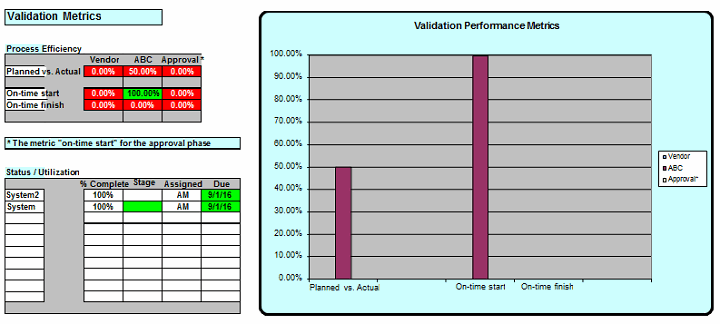5 Steps To Set Effective Goals For A Life Science Consultant
By Allan Marinelli, Quality Validation 360 Inc.

There is a trend within the pharmaceutical, biopharmaceutical, medical device, and vaccine industries to hire more consultants, leading to a staffing ratio that can be up to 50 percent consultants to staff for small to large capital projects. This is done to accommodate the need to complete projects within as tight a timeframe as possible, as companies attempt to be ahead of the competition without compromising the quality of the product. As a result, clients must set appropriate goals before hiring consultants to ensure the project is completed as efficiently and effectively as possible despite the potential obstacles that can obstruct the path of focus.
This article will focus on five essential steps to set appropriate goals for a successful client/consultant relationship:
- Step 1: Establish a developmental project plan.
- Developmental plan (optional for large capital projects)
- Management user requirements (optional for large capital projects)
- Establish short-term objectives
- Establish long-term objectives
- Step 2: Prioritize the goals using a scientific risk-based approach.
- Can use a FDMEA approach in Excel format
- Can use a matrix approach or tabular approach
- Can use ASTM-E2500-13 or ICH-Q9 approach
- Step 3: Identify the methods necessary to achieve the goals.
- Develop a checklist
- Post goals above your desks or print the goals and attach the printouts in a close visual proximity
- Provide hard or electronic copies to all team members involved that support the attainment of the goals
- Write notes on the fly in your numbered hard-covered book as you meet with individual stakeholders (those involved in the attainment of the goal) or during your kickoff meeting/other meetings
- Step 4: Establish a measurement system to measure progress during the execution phase.
- You can use matrix table against the management user requirements or develop metrics against the management user requirements
- Step 5: Produce weekly status reports against the objectives.
- Weekly report
- Weekly meeting
- Weekly wrap-ups including follow-up and projected tasks for the subsequent week
- Performance evaluation
The following sections will describe each step in further detail.
1. Establish a developmental project plan.
Within the first week that the consultant meets the client, the client should have a developmental plan in place that factors in the complexity of the project. For example, if this involves a small capital project, the client should ensure that short-term and long-term goals are transcribed within the plan in tabular form and submitted to the consultant with an explanation for each of the goals. The short-term goals may be re-evaluated as project changes occur, while factoring in a backup or short-term contingency objective as a substitute plan in case hurdles or showstoppers emerge during execution of the short-term goals.
If, on the other hand, the project involves a large capital project, the client can provide to the consultant the business user requirements (BURs) or management user requirements (MURs) over and above the short- and long-term goals. The MURs can be identified through a traceable numbering system — analogous to using a computer system lifecycle validation approach or GAMP 5 principles — using a tabular method or matrix table in which the client would identify the list of tasks mandated or requested. Each numbered task will reference a corresponding test or verification method that is intended to be performed to meet the client’s MURs. As additional information is provided during the course of the project, the MUR document will be updated by modifying, deleting, or adding numerical MURs as part of its life cycle paradigm.
Note: The client is expected to have all or most of the MUR identifiers listed prior to onboarding the consultant so that when the consultant arrives he/she can continue to populate the relevant information in the test field or other fields where warranted.
2. Prioritize the goals using a scientific risk-based approach.
Once you identify the list of short- and long-term goals you can prioritize your goals using any of the scientific risk-based tools, including, but not restricted to, FDMEA (failure design mode and effects analysis), matrix approach, ASTM E2500-13, ICH-Q9, or simply setting business priorities using a conventional tabular method. The method you select should be mutually agreeable to the consultant and client. It is essential that the priorities of the tasks within the short- and long-term goals are agreed to or rationalized up front, and all parties involved concur with the direction of the priorities and the selected tools during the course of the project.

Get tips from expert Kelly Thomas on ASTM E2500 in the webinar:
Implementing the ASTM E2500 Validation Method: 10 Years of Key Learnings
3. Identify the methods necessary to effectively achieve the goals.
Once the priorities are established sequentially, in parallel, or in series, or in a combination of both series and parallel, the following steps are recommended to ensure that the tactics or methods will effectively attain the goals:
- Develop a checklist.
- Post the goals above your desk or print the goals and attach the printouts in a close visual proximity of your computer/desk.
- Provide hard or electronic copies to all team members (stakeholders) involved.
- Write notes on the fly in your numbered hard-covered book as you meet with individual stakeholders and/or during your formal or informal meetings.
Note: Since the projects do not necessarily flow in a linear fashion despite having a developmental plan in place, the consultant can adhere as much as possible to the plan while attempting to connect as many dots as possible to understand the details of the projects by communicating with the various stakeholders. This will aid in putting together a realistic checklist, leading to a smooth execution of the goals.
4. Establish a measurement system to monitor progress during the execution phase.
In recent years, companies have been using performance metrics such as key performance indicators (KPIs) or process outcomes and results that focus on relevant drivers or enablers to allow the team to see where they stand in the project. Oftentimes, people are confused by objectives or goals, and metrics. The metrics monitor or confirm whether the objectives have been attained by using a measurement system that evaluates whether target goals are reached.
You can use a matrix table against the management user requirements or develop a metric against the management user requirements. You can also develop a metric for a right first time scenario. One example of the right first time metric is shown below:

5. Produce weekly status reports against the objectives.
The following weekly conclusions are recommended to ensure a smooth transition toward reaching the objectives and MURs:
- Weekly report
- Weekly meeting
- Weekly wrap-ups, including following up and projected tasks for the subsequent week
- Performance evaluation (client to consultant and consultant to client feedback)
It is recommended that the client let the consultant know where they stand on a weekly basis (i.e., short-term and long-term goals being met or whether the consultant is going in the right direction) against the MURs, rather than waiting to let the consultant know where they stand; otherwise, the consultant will not only burn hours but will be set up to not provide added value to the project during that period. Furthermore, the client will have difficulty correctly evaluating the consultant’s capabilities or qualifications for the mandated tasks in question.
Conclusion
When the engineering manager (client) follows the aforementioned Five Steps on a weekly basis, including following up with weekly reports, following up to align short-term and long-term objectives with the management user requirements, using a measurements system/approach (e.g., metric, right first time, etc.), and letting the consultant know about his or her performance, the client will improve the chance that projects will go smoothly and that the management user requirements will be achieved.
Reference:
- Inspired by an article by the author titled “Client and Consultant – Defining Short Term and Long Term Goals,” pending final publication in the Journal of Validation Technology in 2018.
About The Author:
 Allan Marinelli acquired over 25 years of worldwide cGMP experience (in Belgium, France, South Korea, China, India,Canada, the U.S.) under the FDA, EMA, SFDA,KFDA, WHO, and other regulations. He is currently the president/CEO of Quality Validation 360 Incorporated, providing consultation services to the (bio)pharmaceutical, medical devices, vaccines, and food/beverage industries. Mr. Marinelli has authored peer-reviewed papers (Institute of Validation Technology) and chapters on validation, risk analysis, environmental monitoring in PDA (Parenteral Drug Association) books, and chapters on cleaning validation in PDA books. In addition, Mr. Marinelli published peer-reviewed articles on Pharmaceutical Online, Bioprocess Online, and Outsourced Pharma in 2016 and 2017. He is an associate member of ASQ (American Society for Quality) and published an article in ASQ titled “Against the Grain, Standing your ground when senior majority rules” in Quality Digest (Aug. 2014). He may be contacted at amarinelli360@gmail.com.
Allan Marinelli acquired over 25 years of worldwide cGMP experience (in Belgium, France, South Korea, China, India,Canada, the U.S.) under the FDA, EMA, SFDA,KFDA, WHO, and other regulations. He is currently the president/CEO of Quality Validation 360 Incorporated, providing consultation services to the (bio)pharmaceutical, medical devices, vaccines, and food/beverage industries. Mr. Marinelli has authored peer-reviewed papers (Institute of Validation Technology) and chapters on validation, risk analysis, environmental monitoring in PDA (Parenteral Drug Association) books, and chapters on cleaning validation in PDA books. In addition, Mr. Marinelli published peer-reviewed articles on Pharmaceutical Online, Bioprocess Online, and Outsourced Pharma in 2016 and 2017. He is an associate member of ASQ (American Society for Quality) and published an article in ASQ titled “Against the Grain, Standing your ground when senior majority rules” in Quality Digest (Aug. 2014). He may be contacted at amarinelli360@gmail.com.
